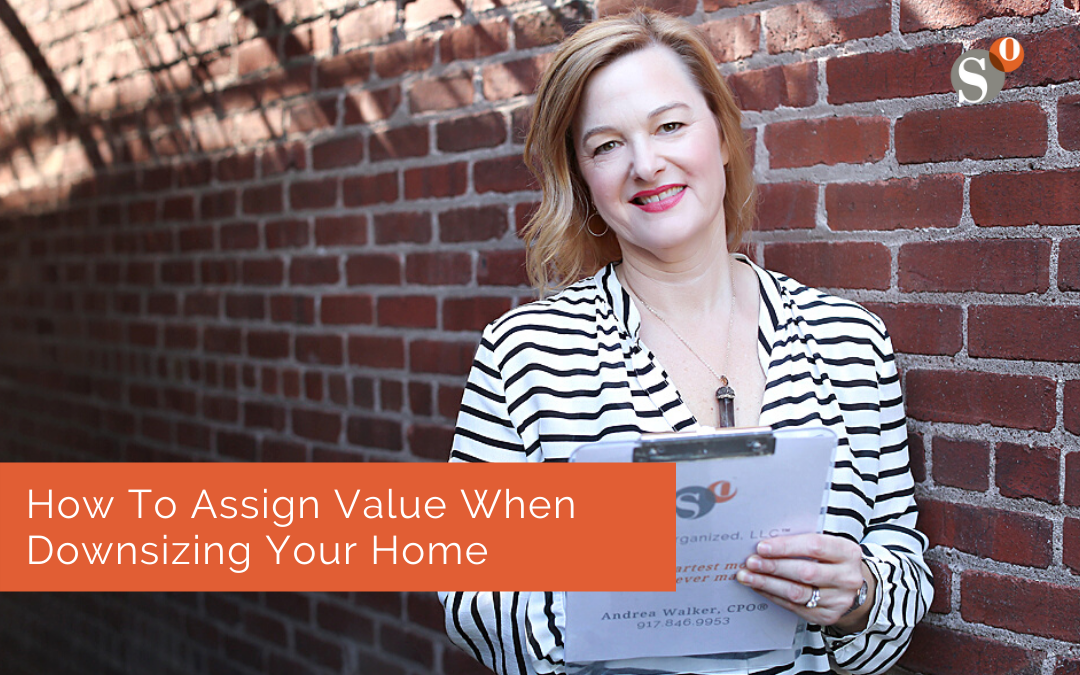Value ˈvalyo͞o/ — the regard that something is held to deserve; the importance, worth, or usefulness of something
Clearing out a family home is challenging work…in many regards. Understanding and being sympathetic to the value family members assign to their possessions is critical to success. We all have different feelings and opinions; that’s what makes the world go ‘round; right? I have witnessed both ends of the spectrum — from clients who just want everything cleared out and disposed of as quickly as possible to the clients who “valued” everything and needed to touch every item (including every piece of paper) before making a disposition decision as well as those who want to keep everything including Johnnie’s baby teeth to every piece of Susie’s pre-school artwork.
In order to determine how to handle all your “stuff,” create value categories. Ask yourself – “how useful or important is this item to me?” and/or “how much $$ is it worth?” Consider these categories of value as you sort and organize and be sure to check out “Six Easy Steps for Downsizing Your Home.”
Memorabilia Value
Memorabilia are objects kept or collected because of their historical interest, especially those associated with memorable people or events. Items that you may want to save include photos, special letters, awards, diplomas, family history, documents, and genealogy; etc. Medals, pins, buttons, posters, buttons, and the like may be of particular interest at local historical societies or organizations where you or your loved one was active. I recently saw a collection of items displayed at a rehabilitation center in Connecticut where my father was recovering. The facility was established in 1892 as the Odd Fellows Home of Connecticut and continues today as a non-profit home for seniors offering independent living and skilled nursing. It was interesting to see the collection of vintage items dating back over 100 years so prominently displayed for visitors and residents. These items are collected from members and their families.
Sentimental Value
Sentimental items prompt feelings of tenderness, sadness, or nostalgia. Sentimental items that you may want to save are things like Grandma’s favorite apron, hand-made quilts, jewelry, special gifts, etc. But you may also find that you have a large volume of printed photographs, or other items saved from your kids and their activities when they were growing up. These items may be hard to part with as your consider you space limitations in your new home. There are many ways to “shrink” or reduce the space they require such as digitizing your photos, or creating photo books of artwork and newspaper clippings, awards your kids earned, etc. Larger items like T-shirts can be transformed into usable quilts while old, threadbare quilts can be transformed into stuffed animals or purses. These transformations allow you to use and appreciate these items without taking up so much physical space.
Monetary Value
When downsizing your home it’s likely that you need to part with 50% or more of your stuff. The vast majority of this stuff may still have some monetary value. Monetary value is the value or worth that an item would bring to someone if sold today. It’s important to distinguish between the price you paid when you purchased it and the value today. Furniture styles change as evidenced by the increased interest in mid-century modern furniture. Victorian style antiques are less valuable these days along with less interest in things like formal china, silver, and other traditional wedding gifts. That said, there are no hard and fast rules. How and where you can monetize them depends on many factors. It pays (pun intended) to explore selling any and all items. Check out our post about “Six Easy Steps for Downsizing Your Home.”
Donation Value
Despite the above, be mindful about assigning too great a value to household items. As you are segregating your possessions between keep or toss it can be hard to see the forest through the trees. Even if you no longer need or want an item it may still be useful and, therefore, hold some value. Beware this trap. I am reminded of the “banana stand” that a client suggested I try to sell. Under other circumstances I might have gladly tried to sell it via social media as a client accommodation, or supported my client’s desire to sell it themselves, but, when downsizing 40 years of stuff it makes more sense to let these lower value items go to donation. The investment of time will far outweigh the monetary return. I encourage my clients to focus on the bigger ticket items and let the rest go to those in need. There are plenty of easy ways to pass things on to those in need and avoid landfills.
Often, folks need help (that’s where a Professional Organizer can step in) with making smart and realistic decisions in terms of what they will keep and how — Will you have the space? Will you incur a financial burden by rental of storage facilities? Once you have evaluated and classified the estate/your belongings and you see what you have, you can make the proper decisions on specifically how you will liquidate/clear out the property. It’s usually a combination of activities. For more information check out our post “How to Downsize Your Possessions When You Move.”
If you want to learn more feel free to call or email me at Andrea@SmartlyOrganized.com or 917-846-9953.
It’s the smartest move you’ll ever make…


